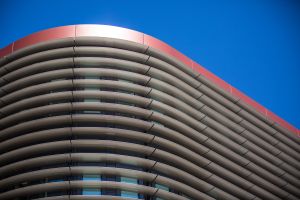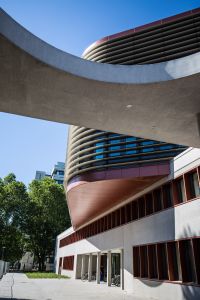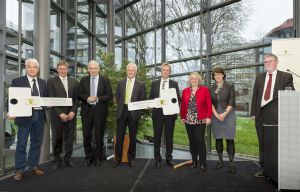High-performance materials for future energy supply, e.g. for batteries and organic solar cells, are in the focus of research that is to be conducted by the Material Research Center for Energy Systems (MZE) of Karlsruhe Institute of Technology (KIT). In its direct vicinity, the Microtribology Center µTC of the Fraunhofer Society will study scientific aspects of friction and wear processes. Today, the opening ceremony for both buildings took place on Campus South of KIT in the presence of Baden-Württemberg Minister of Science Theresia Bauer, State Secretary of the Ministry of Finance of Baden-Württemberg Gisela Splett, the President of KIT Professor Holger Hanselka, and the Member of the Executive Board of the Fraunhofer-Gesellschaft Professor Alfred Gossner.

The new MZE building will accommodate 150 researchers of chemistry, physics, materials sciences, electrical engineering, and process technology. (Photo: Manuel Balzer, KIT)
“Materials research is the basis for future innovations, because new materials lead to new technologies. In the areas of energy conversion and energy storage, for instance, we are facing major challenges relating to materials technology. Here, the MZE with its interdisciplinary research can make an important contribution to the energy transition,” underlined Minister of Science of Baden-Württemberg Theresia Bauer. In the opinion of Bauer, the new Microtribology Center even strengthens Karlsruhe as a location of cutting-edge research and KIT extends its collaboration with the Fraunhofer Society in the area of applied research.
“Materials research is a topic of high relevance to many research activities at KIT. In particular, it is needed to address the technological challenges faced in connection with the energiewende. The MZE will contribute to finding solutions by the development of new battery materials and printable solar cells. KIT researchers of several disciplines already cooperate closely. I am very pleased that the MZE will now enhance their collaboration and decisively push the development of innovative material concepts,” the President of KIT, Professor Holger Hanselka, said.
“Reduction of friction and wear, which is in the focus of the Microtribiology Center, is an economically and industrially relevant topic. Smart solutions will help save costs. Progress requires cooperation of disciplines, such as physics, chemistry, and mechanics. Hence, this topic is predestined for being studied at such a place and for being pushed for the benefit of industry and society. We are very pleased to help create the prerequisites for a successful combination of KIT’s fundamental research with applied research and development of the Fraunhofer Society,” the Member of the Fraunhofer Executive Board, Professor Alfred Gossner, pointed out.

Research at MZE focuses on printable, organic solar cells and rechargeable battery systems. (Photo: Manuel Balzer, KIT)
Innovative Materials for Future Energy Supply: The Material Research Center for Energy Systems of KIT
Research of the MZE will focus on innovative materials for efficient energy conversion and storage. The MZE will pursue a highly interdisciplinary approach. About 150 scientists of chemistry, physics, materials sciences, electrical engineering, and process technology will work here. They will study the complete process chain from the molecule to the component, including process technology, characterization, modeling, and simulation of new materials for energy systems. “Work of the MZE will concentrate on printable, organic solar cells and rechargeable battery systems. These systems are to have high energy and power densities for use in electric mobility, very long service lives with low costs per energy stored, and a charge / discharge cycle for stationary storage systems. In addition, the scientists will develop new processes for the economically efficient large-scale production of these innovative materials and their use in energy systems,” MZE Coordinator, Professor Michael Hoffmann, explains.
The new building near the Audimax on Campus South of KIT covers an area of 4300 m². The building concept is specially tailored to the interdisciplinary approach pursued. Communication of the working groups and, hence, their cooperation is promoted by the design. The MZE is equipped with modern facilities and devices for the production and characterization of the newly developed materials, including a high-resolution computer tomograph and a novel focused ion beam / scanning electron microscope (FIB-SEM).
Building owner of the MZE is the State of Baden-Württemberg, represented by the Karlsruhe Office of Assets and Construction in Baden-Württemberg. Construction costs amounted to EUR 27.4 million. They are shared at an equal ratio by the State of Baden-Württemberg and the Federal Republic of Germany. The funds were granted in a competition launched by the Baden-Württemberg Ministry of Science, Research, and the Arts to strengthen innovative future technologies in the state. The building was designed by the architectural office Valentyn Architekten in Cologne. Under the “Art in Construction” program, the work of art “Big Mutter” by Erwin Wurm found its home in the MZE building: The overdimensioned, shining red hot water bottle at the building entrance represents “the original form” of an energy storage system.
The MZE will cooperate with the adjacent Microtribology Center µTC in various areas, in particular in modeling and simulation.
More information on MZE: www.mze.kit.edu/english/index.php
The Microtribology Center µTC of Fraunhofer Society
The Microtribology Center µTC of Fraunhofer Society focuses on research into and investigation of friction and wear processes in technical systems. Scientists of the Fraunhofer Institute for Mechanics of Materials IWM and the KIT Institute for Applied Materials jointly work on solutions to reduce or adjust wear and friction in e.g. mechanical engineering, vehicle construction, or energy production. This work is aimed at reducing the consumption of resources, increasing efficiency, and improving the reliability of technical systems.
The costs of the new building in the amount of EUR 6.5 million were financed by the State of Baden-Württemberg and the Federal Republic of Germany at a 50:50 ratio. It accommodates 40 office workplaces as well as laboratories and rooms for experimental facilities.
More about the Microtribology Center µTC: www.mikrotribologiecentrum.de (in German only)
In close partnership with society, KIT develops solutions for urgent challenges – from climate change, energy transition and sustainable use of natural resources to artificial intelligence, sovereignty and an aging population. As The University in the Helmholtz Association, KIT unites scientific excellence from insight to application-driven research under one roof – and is thus in a unique position to drive this transformation. As a University of Excellence, KIT offers its more than 10,000 employees and 22,800 students outstanding opportunities to shape a sustainable and resilient future. KIT – Science for Impact.

